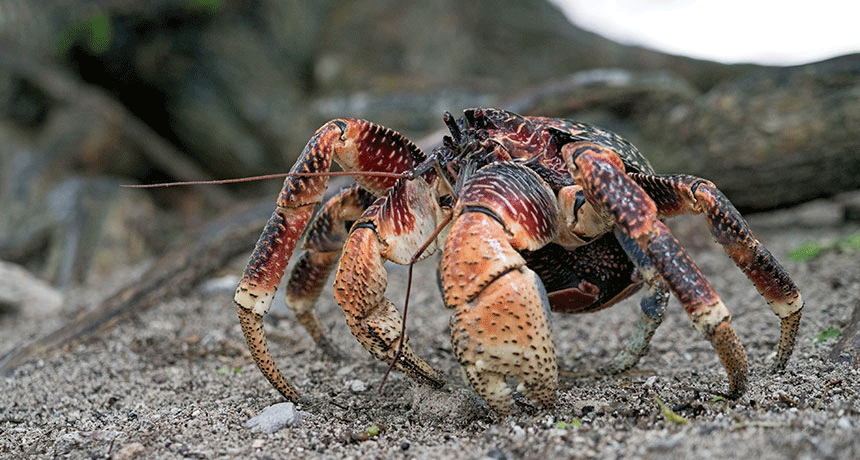Humongous land crab dines on remote-island seabirds
Their attacks may influence where certain birds can survive in one Indian Ocean archipelago

Coconut crabs, the world’s largest invertebrate found on land, have been caught attacking seabirds on remote islands in the Indian Ocean.
Janos/istockphoto
A biologist working on remote islands in the Indian Ocean has witnessed something new. He spotted a coconut crab, the world’s largest land invertebrate, killing and eating a seabird known as a red-footed booby. It’s the first time that such attacks have been reported.
Mark Laidre is a biologist at Dartmouth College in Hanover, N.H. He witnessed the attack in March 2016. He was on a two-month field expedition to study the crabs in the Chagos Archipelago.
Laidre is an expert on hermit crabs. But he had been “dying to study” their humongous cousins, which can have a leg span wider than a meter (three feet) and can weigh more than four kilograms (nine pounds). Little is known about the crabs, he notes. A study earlier this year looked at the force that a coconut crab’s claw can exert in the lab. But, he says, “there’s still not a single paper on how they open a coconut.”
So he trekked to a remote spot in the Indian Ocean. (He wanted to study the crabs in a place where few people were around to interfere with their natural behaviors.) Laidre had heard tales of coconut crabs killing rats. He later witnessed the crabs munching on the islands’ rodents. “Clearly,” he says, “it’s in their repertoire to eat something big.” And when he took inventory of the crabs’ burrows, he found one held the carcass of an almost full-grown red-footed booby. “At the time,” he recalls, “I had assumed it was something that had died … and the crab had dragged in there.”
Then, in the middle of one night, he saw a crab attack a sleeping bird. The crab scaled a tree and then dragged the bird off of a branch and onto the ground. There, it broke the bird’s bones. Laidre managed to catch part of the event on film. “I didn’t have the heart to videotape five coconut crabs tearing apart the bird later,” he says. “It was a little bit overwhelming. I had trouble sleeping that night.”
Afterward, Laidre heard a story from a local plantation worker. The man had witnessed something similar a few years earlier. Laidre says: “He was sitting and eating a sandwich, and this coconut crab came right out its burrow in the middle of the daytime.” A red-footed booby had just landed outside. The crab quickly grabbed one of its legs and pulled the bird into the burrow. “The bird never emerged.”
Ruling with fear
It’s difficult to know how common such attacks are. “Predation itself is something you don’t often witness,” Laidre notes. He’d like to someday install camera traps on the islands to get a better sense of the crabs’ behavior.
While in the Chagos, he did find himself in a sort of natural experiment, though. It gave him some insight into the effect of the crabs on local bird populations. Coconut crabs live on only some of islands of that archipelago. Birds can live on any of them, yet their populations vary widely from island to island. So Laidre surveyed the islands. He walked transects, counting crabs and bird nests.
“The pattern I found across the island was pronounced,” Laidre writes November 1 in Frontiers in Ecology and the Environment. On one island, Diego Garcia, for example, a 15-kilometer (9-mile) transect revealed 1,000 crabs and no nesting birds. Crab-free West Island, in contrast, had an abundance of ground nests of a bird species known as nesting noddies.
Laidre suspects that the coconut crabs act as a “ruler of the atoll.” They may keep ground-nesting bird species from finding homes on crab-filled islands. On islands with large populations of birds, those birds might help to keep their islands crab-free by eating juvenile coconut crabs. That could prevent the crabs from coming to rule those islands.
“It’s easy to sympathize with the prey,” Laidre says, “but at the same time, there’s a lot of ecological roles that that sort of action has.”







